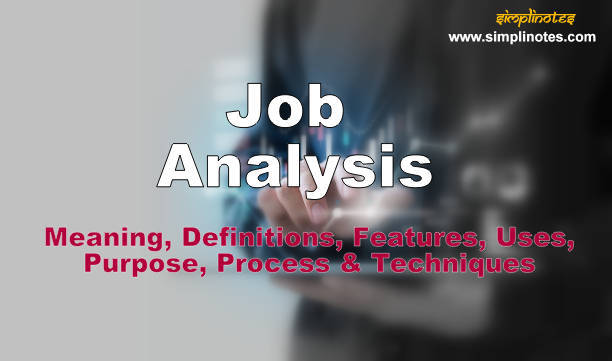Process of Job Analysis
Job analysis is a sequential process undergoing the following steps
1. Organizational Analysis
First of all an overall view of various jobs in the organisation is obtained. This is required to judge the linkages between jobs and the organisational goals, interrelationships among jobs, and the contribution of various jobs to efficiency and effectiveness of the organisation. For this purpose, background information is collected in the form of organisation charts, class specifications, work flow charts, etc. Organisation charts show the relation of the job with other jobs in the organisation. Class specifications describe the general requirements of the job family. Work flow charts indicate the flow of activities involved in a job.
2. Organising Job Anatysts Programme
It is necessary to plan and organize the programme and must assign responsibilities. A budget and a time schedule should be developed.
3. Deciding the Uses of Job Analysis Information
It has been stated above that information generated by job analysis can be utilized for practically all functions of human resource management. Nevertheless, it is desirable to focus on a few priority areas in which the job analysis information is to be used. These areas can be decided on the basis of the need, priorities and constraints of the particular organisation. How the job information will be used and for what purpose will determine the extent to which jobs are to be analyzed.
4. Selecting Representative Jobs for Analysis
It would be highly time consuming and costly to analyze all the jobs. It is, therefore, desirable to select a representative sample of jobs for the purpose of detailed analysis. Priorities of various jobs needing analysis can also be determined.
5. Understand Job Design. The job analyst should obtain information concerning
the current design of the representative job. For this purpose, current job description and job specification. procedure manual, systems flow charts, etc. can be studied.
6. Collection of Data
In this step, data on the characteristics of the job, and qualifications and behaviour required to do the job effectively is collected. Data may be collected from the employees who actually perform the job, or from their super- visors or from outsiders called trade job analysts appointed to watch employees performing the job. Several techniques are available for job analysis. Care should be taken to use only those techniques which are acceptable and reliable in the given situation.
7. Developing a Job Description.
This step involves describing the content of the job in terms of functions, duties, responsibilities, operations etc. The job holder is required to discharge the duties and responsibilities and perform the operations listed in job description.
8. Preparing a Job Specification.
This step involves conversion of the job description statements into a job specification. Job specifications is a written statement of personal attributes in terms of traits, skills. Training, experience needed to carry out the job.
Purpose of Job Analysis
It is very important to identify and well define the purpose of job analysis. In this regard, following points must be considered
- If the organisation does not have a person who is well trained to conduct it effectively then job analysis consultant prove to be extremely helpful as they offer unbiased advice, guidelines and methods. Therefore, it will be good to analyse a job without any personal likes and dislikes.
- It is necessary to have a planned approach about how to carry the whole process in order to investigate a specific job.
- If the person is not an expert then it is extremely important to schedule training for the job analyst.
- It is also mandatory for the HR Managers to communicate the whole thing properly. So, that employees offer their full support.
- It is required to very careful and conscious while collecting data related to educational qualifications of employees, skills and abilities required to perform the job.
- Logical, rational and analytical approach is required to verify the authenticity of collected data as it will be the final information to describe a specific job.
- Job description and job specification also needs to be dealt carefully as job description will describe the roles, activities, duties and responsibilities of the job and job specification will describe educational qualifications, experience, personal traits required to perform a job.

